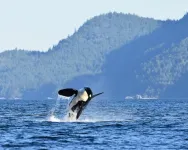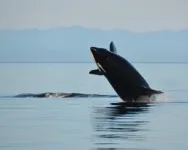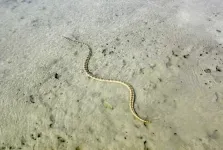(Press-News.org) Monika Wieland Shields, Director of the Orca Behavior Institute, has observed orcas in the Salish Sea, a marginal sea of the Pacific Ocean located in the Canadian province of British Columbia and the U.S. state of Washington, since 2000. She has recently published an article in the peer-reviewed Open Access journal PeerJ Life & Environment that provides crucial insights into the changing habitat usage of the critically endangered Southern Resident killer whales (Orcinus orca), shedding light on historic trends and the current status of the population in the Salish Sea. We caught up with Monika to find out more about her research and the orcas she is so passionate about.
Can you tell us a bit about yourself?
My name is Monika Wieland Shields and I’m the co-founder and director of the non-profit Orca Behavior Institute (OBI) based on San Juan Island, Washington, USA. We conduct non-invasive behavioral and acoustic research on two populations of killer whales that frequent the regional inland waters known as the Salish Sea: the endangered fish-eating Southern Resient killer whales and the thriving mammal-eating Bigg’s killer whales. I have been studying, photographing, writing about, and advocating for these whales for over 20 years, and am the author of the 2019 book “Endangered Orcas: The Story of the Southern Residents”.
Can you briefly explain the research you published in PeerJ?
One of my long-term projects at OBI is tracking the shifting habitat usage of Southern Resident killer whales. Their seasonal usage of the Salish Sea has changed dramatically since their endangered listing in 2005, correlating with shifts in their preferred prey. This study provides an update on daily whale occurrence from 2018-2022 showing that these shifts are continuing to occur.
What did you discover and where?
The focus of this study is the inland waters of Washington State and British Columbia, a region known as the Salish Sea. This study shows that historic Southern Resident habitat use of this area has essentially reversed: they used to be most abundant here from May through September, but now occur more in the fall and winter months while their spring and summer presence has declined dramatically.
What was significant about your findings?
Protecting habitats is a key component of endangered species recovery, but to be biologically meaningful, any geographic or temporal protection zones need to overlap in space and time with how the target species is currently using the habitat, rather than based on historic trends. Both Canada and the US have implemented regional and seasonal protection measures aimed at supporting population recovery, but it is important that they are regularly updated to reflect shifting habitat usage by the Southern Residents. This study fills that data gap by demonstrating how these endangered orcas are utilizing the Salish Sea over the last 5 years and how that has shifted from previous trends.
Read the full article 2018–2022 Southern Resident killer whale presence in the Salish Sea: continued shifts in habitat usage published in PeerJ Life & Environment.
END
2018–2022 Southern Resident killer whale presence in the Salish Sea: continued shifts in habitat usage
2023-07-12
ELSE PRESS RELEASES FROM THIS DATE:
$3.9M grant funds e-cigarette flavoring research at Ohio State’s Center for Tobacco Research
2023-07-12
COLUMBUS, Ohio - A new $3.9 million grant from the U.S. Food and Drug Administration (FDA) will allow researchers with the Center for Tobacco Research at The Ohio State University Comprehensive Cancer Center to evaluate effects of e-cigarette flavors on the smoking behaviors of current adult smokers.
The study, co-led by Theodore Wagener, PhD, director of Ohio State’s Center for Tobacco Research, and Tracy Smith, PhD, of the Medical University of South Carolina (MUSC) Hollings Cancer Center, will be the first ...
Gut bacteria linked to fatty deposits in heart arteries
2023-07-12
In a major Swedish study, researchers have discovered a link between the levels of certain bacteria living in the gut and coronary atherosclerotic plaques. Such atherosclerotic plaques, which are formed by the build-up of fatty and cholesterol deposits, constitute a major cause of heart attacks. The study was led by researchers at Uppsala and Lund University and the findings have now been published in the scientific journal Circulation.
The new study was based on analyses of gut bacteria and cardiac imaging among 8,973 participants aged 50 to 65 from Uppsala and Malmö without previously known heart disease. They were all ...
Study reveals new mechanism for rapid evolution of multi-drug resistant infections in patients
2023-07-12
Findings challenge the traditional view that antimicrobial resistance (AMR) emerges from pathogens that acquire new mutations
Samples from ICU patients suggest that instead, highly diverse pathogen communities harbour pre-existing resistant genotypes
The results suggest that interventions aimed at limiting the spread of bacteria between patients may provide a powerful approach to combat AMR.
A research study led by the University of Oxford provides a transformational new insight into how antimicrobial resistance (AMR) emerges in patients with bacterial infections. The findings, published today in the journal ...
Blood pressure patterns in the first half of pregnancy improve early prediction of preeclampsia and gestational hypertension
2023-07-12
Routine blood pressure readings recorded in the first half of pregnancy can be divided into 6 distinct patterns that can effectively stratify patients by their risk of developing preeclampsia and gestational hypertension later in pregnancy, Kaiser Permanente researchers found.
The study, published July 12 in the Journal of the American Heart Association, showed that 6 pregnancy blood pressure trajectories seen within the first 20 weeks of pregnancy along with clinical, social, and behavioral risk factors can accurately predict and stratify risk of preeclampsia and gestational hypertension in low- to moderate-risk patients. ...
Gulf War illness caused by mitochondrial dysfunction, not inflammation
2023-07-12
Gulf War Illness (GWI) is a chronic multisymptom health condition affecting one-third of all veterans who served in the 1991 Gulf War, most of whom remain afflicted more than 30 years later. Common symptoms include fatigue, headaches, muscle aches, joint pain, diarrhea, insomnia and cognitive impairment.
The condition is believed to have been triggered by veterans’ exposure to environmental toxins. However, its exact mechanism in the body continues to be debated, making it difficult to diagnose and treat. The prevailing ...
Queen Mary-led research uncovers why people who have Down’s Syndrome age prematurely
2023-07-12
An overdosed gene on chromosome 21 causes people with Down’s Syndrome to age faster than the general population.
The molecular processes responsible for natural ageing of cells are poorly understood. Studying conditions in humans where ageing is accelerated due to genetic causes presents opportunities to learn about the mechanisms that control ageing and devise strategies to slow down the ageing process.
Adults who have Down’s Syndrome (DS) show earlier signs of ageing-related conditions: reduction in tissue regenerative capacity, alopecia, dry skin, ...
Scientists find evidence of world’s oldest glaciers
2023-07-12
Scientists have discovered the traces of the world’s oldest known glaciers, dating from 2.9 billion years ago, in rocks sitting under the world’s largest gold deposits in South Africa. This suggests the presence of continental ice caps at that time and that either the area was closer to the poles, or that parts of the Earth may have been frozen in a previously unknown “snowball Earth” period of extreme cold weather. This work is presented for the first time at the Goldschmidt geochemistry conference in Lyon, after recent peer-reviewed ...
Sea snakes may have evolved to see colors again
2023-07-12
A new paper in Genome Biology and Evolution, published by Oxford University Press, finds that the annulated sea snake, a species of venomous snake found in ocean waters around Australia and Asia, appears to have evolved to see an extended palette of colors after its ancestors lost that ability in response to changing environments.
Color vision in animals is primarily determined by genes called visual opsins. While there have been multiple losses of opsin genes during the evolution of tetrapods (the group including amphibians, reptiles, and mammals), the emergence of new opsin genes is extremely ...
Supercomputer used to simulate winds that cause clear air turbulence
2023-07-12
A research group from Nagoya University has accurately simulated air turbulence occurring on clear days around Tokyo using Japan’s fastest supercomputer. They then compared their findings with flight data to create a more accurate predictive model. The research was reported in the journal Geophysical Research Letters.
Although air turbulence is usually associated with bad weather, an airplane cabin can shake violently even on a sunny and cloudless day. Known as clear air turbulence (CAT), these turbulent ...
Sea snake vision evolved to regain color
2023-07-12
An international team of scientists examining the genetic history of sea snakes have found that the species has enhanced their colour vision in response to living in brighter and more colourful marine environments.
“Our research has found that the annulated sea snake possesses four intact copies of the opsin gene SWS1,” said PhD candidate Isaac Rossetto, from the University of Adelaide’s School of Biological Sciences who led the study.
“Two of these genes have the ancestral ultraviolet sensitivity, and two have evolved a new sensitivity to the longer wavelengths that dominate ocean habitats.
“The earliest ...







